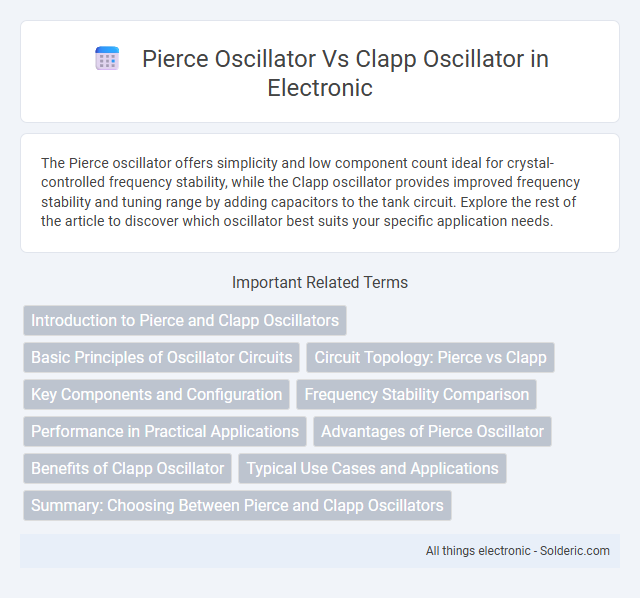The Pierce oscillator offers simplicity and low component count ideal for crystal-controlled frequency stability, while the Clapp oscillator provides improved frequency stability and tuning range by adding capacitors to the tank circuit. Explore the rest of the article to discover which oscillator best suits your specific application needs.
Comparison Table
| Aspect | Pierce Oscillator | Clapp Oscillator |
|---|---|---|
| Oscillator Type | Crystal-controlled oscillator | LC oscillator with frequency stabilization |
| Frequency Stability | High, due to crystal resonance | Moderate, improved over Colpitts by added capacitor |
| Frequency Determining Components | Crystal and load capacitance | Inductor and three capacitors (including series capacitor) |
| Phase Shift | Crystal provides phase shift | Phase shift controlled by LC network, especially series capacitor |
| Typical Application | Precision frequency sources, clocks | Variable frequency oscillators, RF circuits |
| Output Waveform | Stable sine wave | Stable sine wave |
| Complexity | Simple, fewer components | More complex, additional capacitor for tuning |
| Tuning Capability | Limited, crystal fixed frequency | Good tuning range via capacitor adjustment |
Introduction to Pierce and Clapp Oscillators
Pierce and Clapp oscillators are popular crystal oscillator circuits used for generating stable frequencies in electronic devices. The Pierce oscillator utilizes a single transistor or inverter with a crystal and two capacitors to create a simple and low-power frequency source. The Clapp oscillator enhances frequency stability by adding a capacitor in series with the crystal, reducing frequency drift and improving precision in Your applications.
Basic Principles of Oscillator Circuits
The Pierce oscillator uses a quartz crystal and a single transistor amplifier to maintain stable oscillations by exploiting the crystal's resonant frequency, providing high frequency stability and low phase noise. The Clapp oscillator, a variant of the Colpitts oscillator, incorporates an additional capacitor in series with the inductor to refine frequency stability and reduce amplitude variations by improving the tank circuit's quality factor. Both oscillators rely on positive feedback and phase shift conditions to sustain oscillations, but the Pierce oscillator emphasizes crystal-based frequency control while the Clapp oscillator focuses on improved LC tank circuit precision.
Circuit Topology: Pierce vs Clapp
The Pierce oscillator features a simple circuit topology utilizing a single quartz crystal, a pair of capacitors, and an inverter, offering high frequency stability with minimal components. In contrast, the Clapp oscillator adds a series capacitor to the tank circuit, enhancing frequency tuning precision and reducing the influence of transistor parameters on oscillation frequency. Your choice between Pierce and Clapp oscillators depends on the required frequency accuracy and circuit complexity for your application.
Key Components and Configuration
The Pierce oscillator primarily uses a quartz crystal, two capacitors, and a single transistor or inverter, arranged in a feedback loop where the crystal provides frequency stabilization through its inherent piezoelectric properties. The Clapp oscillator enhances this configuration by adding an extra capacitor in series with the crystal, which improves frequency stability and reduces oscillator distortion by allowing finer tuning of the resonant frequency. Both oscillators rely on a tuned feedback network but differ significantly in capacitor arrangement and frequency control mechanisms, impacting their application suitability in precision timing circuits.
Frequency Stability Comparison
The Clapp oscillator generally offers superior frequency stability compared to the Pierce oscillator due to its additional capacitor that better compensates for component variations and environmental changes. The Pierce oscillator, while simpler and widely used, tends to have lower frequency stability because its frequency depends more heavily on the crystal and stray capacitances. Overall, the Clapp oscillator's design provides enhanced robustness against temperature fluctuations and load capacitance variations, resulting in more consistent frequency output.
Performance in Practical Applications
Pierce oscillators provide stable frequency output with low power consumption, making them ideal for clock generation in microcontrollers and communication devices. Clapp oscillators offer superior frequency stability and lower phase noise due to an additional capacitor in the tank circuit, which enhances performance in high-precision RF applications. You should choose a Pierce oscillator for simplicity and cost efficiency, while a Clapp oscillator suits applications demanding higher frequency accuracy and signal purity.
Advantages of Pierce Oscillator
The Pierce oscillator offers advantages such as a simpler circuit design and fewer components compared to the Clapp oscillator, resulting in lower cost and easier implementation on printed circuit boards. Its low power consumption and stable frequency output make it ideal for microcontroller clock generation and low-frequency applications. The Pierce oscillator's robust performance in maintaining oscillation start-up and steady state also enhances reliability in various electronic systems.
Benefits of Clapp Oscillator
The Clapp oscillator offers improved frequency stability and lower phase noise compared to the Pierce oscillator due to its added capacitor, which enhances tuning precision and reduces sensitivity to component variations. Its design provides better control over the oscillation frequency, making it ideal for high-frequency applications where accuracy is critical. You can achieve more consistent performance in RF circuits and communication devices using the Clapp oscillator's superior stability and phase noise characteristics.
Typical Use Cases and Applications
Pierce oscillators are widely used in low-frequency crystal oscillator applications such as microcontroller clock generation and watch timing due to their simplicity and stability. Clapp oscillators excel in high-frequency applications like RF signal generation and frequency synthesis, where they provide improved frequency stability and tuning range. Your choice depends on whether the priority is low-power, stable frequency control or high-frequency precision and adjustability.
Summary: Choosing Between Pierce and Clapp Oscillators
Pierce and Clapp oscillators both provide stable frequency generation but differ in tuning range and complexity, with the Pierce oscillator favored for simplicity and low power consumption while the Clapp oscillator excels in frequency stability and fine tuning due to its additional capacitive element. Your choice depends on applications requiring minimal component count and moderate stability versus scenarios demanding precise frequency control and enhanced phase noise performance. Understanding the specific frequency accuracy and power requirements of your circuit will guide the optimal selection between these two popular oscillator designs.
Pierce oscillator vs Clapp oscillator Infographic

 solderic.com
solderic.com